Qualcomm Intros Snapdragon X Plus, Details Complete Snapdragon X Launch Day Chip Stack
by Ryan Smith on April 24, 2024 9:15 AM ESTSnapdragon X Plus: Second Verse, A Bit Less Than the First
Alongside today’s announcement of the Snapdragon X chip SKUs and the Snapdragon X Plus branding, Qualcomm put together a short presentation on the Snapdragon X Plus. Given that the underlying hardware is identical to the Snapdragon X Elite, there’s not much to talk about here in terms of technology or technical specs.
But ahead of the mid-year hardware launch, Qualcomm is providing some fresh performance slides, comparing the Snapdragon X Plus to its current-generation competition from Intel and AMD, as well as Qualcomm’s own Snapdragon X Elite. As with all vendor-provided benchmarks, these should be taken with a grain of salt. But if nothing else, it’s notable here what Qualcomm is and isn’t saying.
With 10 high-IPC CPU cores, Qualcomm should fare well in multi-threaded workloads, and this is exactly what they’re opting to promote. According to the company, the Snapdragon X Plus has a significant edge in both performance and power consumption at iso-power and iso-performance respectively. In the case of Cinebench 2024MT, that’s a 28% performance advantage over the Core Ultra 7 155H, or matching that chip’s peak performance at 39% lower power consumption.
Notably, however, what you won’t find from Qualcomm is any material promoting Snapdragon X Plus’s single-threaded performance versus any competition. With those peak clockspeeds of 3.4GHz, the Plus isn’t in a very favorable position versus the 4.8GHz Core Ultra 7 155H, even with what is presumably an IPC advantage.
As far as Qualcomm’s own chips are concerned, the Elite understandably has the advantage at any point on the curve in these MT tests. For a given architecture, a larger number of CPU cores is always the more energy efficient options, never mind the Elite’s clockspeed advantage on top of that. In any case, Qualcomm’s own figures put the Plus at about 15% behind the flagship Elite in Geekbench, and around 20% behind in Cinebench.
The company is also touting an advantage in GPU performance. Though as the benchmark in question is 3DMark Wildlife Extreme, a bencehmark that Qualcomm has already optimized for forwards, backwards, and upside-down within their drivers, I’m more interested in seeing how more PC-exclusive workloads perform. Though to Qualcomm’s credit, they’re no stranger to that space either, as they’ve been shipping Windows-on-Arm Snapdragon SoCs for several years now.
Snapdragon X Plus: Live and In Person
Finally, alongside briefing the press on the Snapdragon X Plus, Qualcomm also had some devices using the new chip SKU to show off, demonstrating the performance of the chip. This setup was similar to Qualcomm’s Snapdragon Summit preview event for the Snapdragon X Elite in October, albeit a bit more free-wheeling and hands-on now that the hardware is a bit more mature and there’s less of a chance of something going awry.
As with that preview event, Qualcomm has equipped their own internal reference design laptops with the chips. With its lower performance, all of the Snapdragon X Plus systems were the “config B” system, which is Qualcomm’s thin-and-light reference design, sporting a 14.5-inch OLED screen and designed for a total system TDP of 23 Watts.
| Qualcomm Snapdragon X Reference Test Systems (Thin and Light) | ||
| AnandTech | Snapdragon X Elite (X1E-80-100) |
Snapdragon X Plus (X1P-65-100) |
| 2 Core Max Turbo | 4.0GHz | 3.4GHz |
| All Core Max Turbo | 12C @ 3.4GHz | 10C @ 3.4GHz |
| GPU | 3.8 TFLOPS | 3.8 TFLOPS |
| RAM | LPDDR5X-8448 | LPDDR5X-8448 |
| Display | 14.5-inch OLED 2880x1800 |
14.5-inch OLED 2880x1800 |
| Thickness | 15mm | 15mm |
| Device TDP | 23W | 23W |
| Cooling | Active | Active |
| Battery | 58Wh | 58Wh |
The Elite version of this laptop was running the X1E-80-100 chip (the same chip as last time) which features a reduced performance GPU, a peak dual-core CPU clockspeed of 4.0GHz, and an all-core turbo of 3.4GHz. Meanwhile the Plus system has an identical GPU and all-core turbo clockspeed, but only 10 CPU cores with a peak dual-core CPU clockspeed of 3.4GHz.
As before, these systems were pre-configured with major benchmarks selected by Qualcomm, including Geekbench 6.2, Cinebench 2024, UL Proycon, PCMark 10, 3DMark, Blender, and new-to-Windows-on-Arm, Chrome. Qualcomm did let us touch these machines this time around, but these demos are still primarily being hosted to prove that Qualcomm is achieving the performance figures they claim.
On that note, here’s a quick rundown of Qualcomm’s performance claims, and what we observed for the Plus in action.
| Qualcomm Snapdragon X Benchmark Scores (Thin and Light) | ||||
| AnandTech | Elite - QC Expected Range | Plus - Observed | Plus - QC Expected Range | Plus vs Elite Performance |
| Cinebench 2024 ST | 121-123 | 109 | 107-109 | 89% |
| Cinebench 2024 MT | 920-980 | 860 | 825-845 | 86% |
| Geekbench 6.2 ST | 2750-2800 | 2420 | 2400-2425 | 87% |
| Geekbench 6.2 MT | 14200-14400 | 13049 | 12800-13100 | 91% |
| Chrome - Speedometer 2.1 | 450-470 | 426 | 410-430 | 91% |
| Chrome - JetStream 2.1 | 310-320 | N/A | 280-290 | 91% |
| PCMark 10 Applications | 12800-13200 | N/A | 12500-12800 | 97% |
| UL Procyon - Office Productivity | 6200-6500 | N/A | 5700-5900 | 91% |
| UL Procyon - AI CV Inference | 1750-1800 | N/A | 1750-1800 | 100% |
| 3DMark Wildlife Extreme | 37.1-38.5 fps | 37.1 | 37.1-38.5 fps | 100% |
| Blender (CPU) | 380-410 | N/A | 340-360 | 88% |
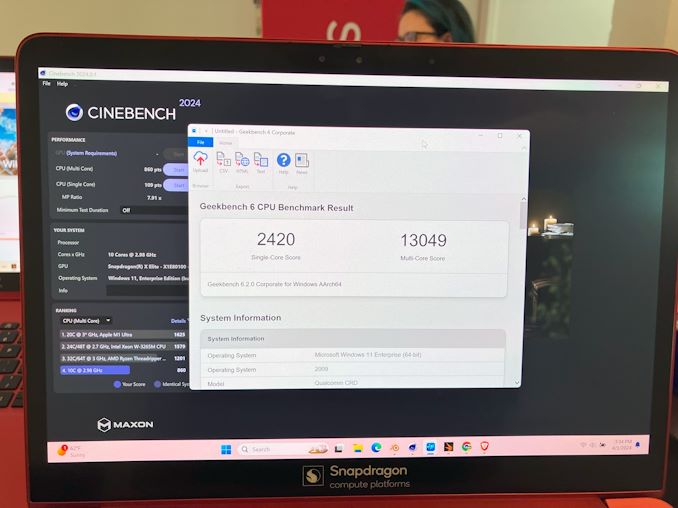
Geekbench 6.2 & Cinebench 2024
And with a little hands-on time, I even convinced Qualcomm’s representative to run the newer Speedometer 3.0 test on Chrome, which has just come out and was not yet part of their official benchmark suite. It scored 22.8.
Notably, here, the Snapdragon X Plus is closer in performance than what clockspeeds alone would predict. In Qualcomm’s supplied benchmark results, the Plus is never more than 14% behind in multithreaded workloads, and 13% behind in single-threaded workloads. And most of the time, it’s a 10% difference or less.
The 23 Watt system-wide TDP limit of the Qualcomm reference system is relatively constraining, all things considered. So I would not be the least bit surprised if the Snapdragon X Elite is being held back, in part, by not being able to run faster within Qualcomm’s systems. In other words, this is a more real-world test, as opposed to testing peak-to-peak unbounded by TDP concerns.
Overall, I don’t know if anything presented with the Snapdragon X Plus thus far would be considered all that surprising. With Qualcomm making their biggest push into the PC market yet, it makes perfect sense that they’re introducing multiple SKUs – and that they’d need some kind of branding to differentiate them. And while the Plus obviously won’t deliver the kind of chart-topping highs that the Elite will, it’s still based on all the same hardware that Qualcomm is banking on to make their reset PC ambitions a success. So like the rest of the Snapdragon X family, I’m looking forward to seeing what the hardware – Oryon CPU cores and all – can deliver when it launches in the middle of this year.


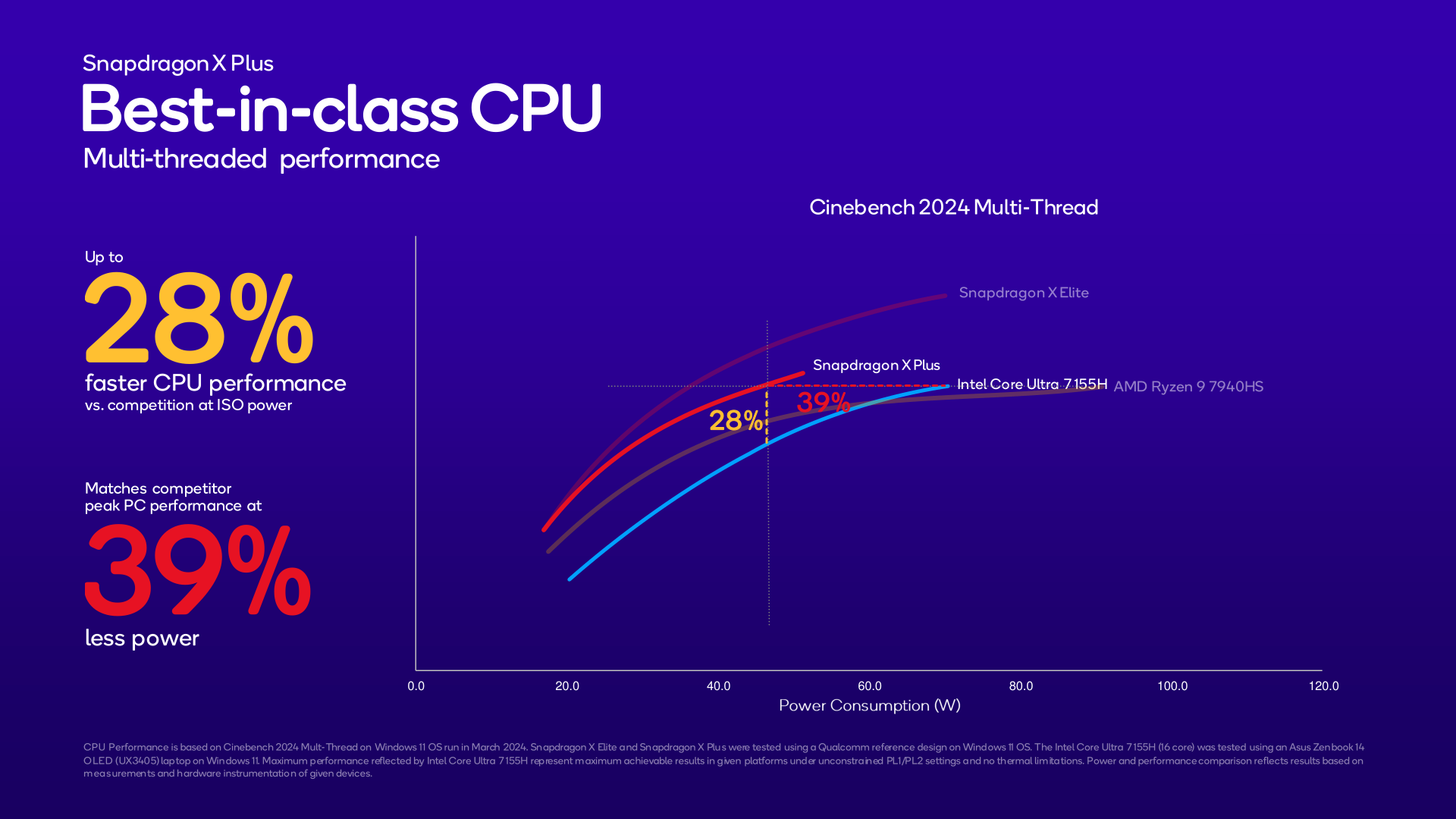
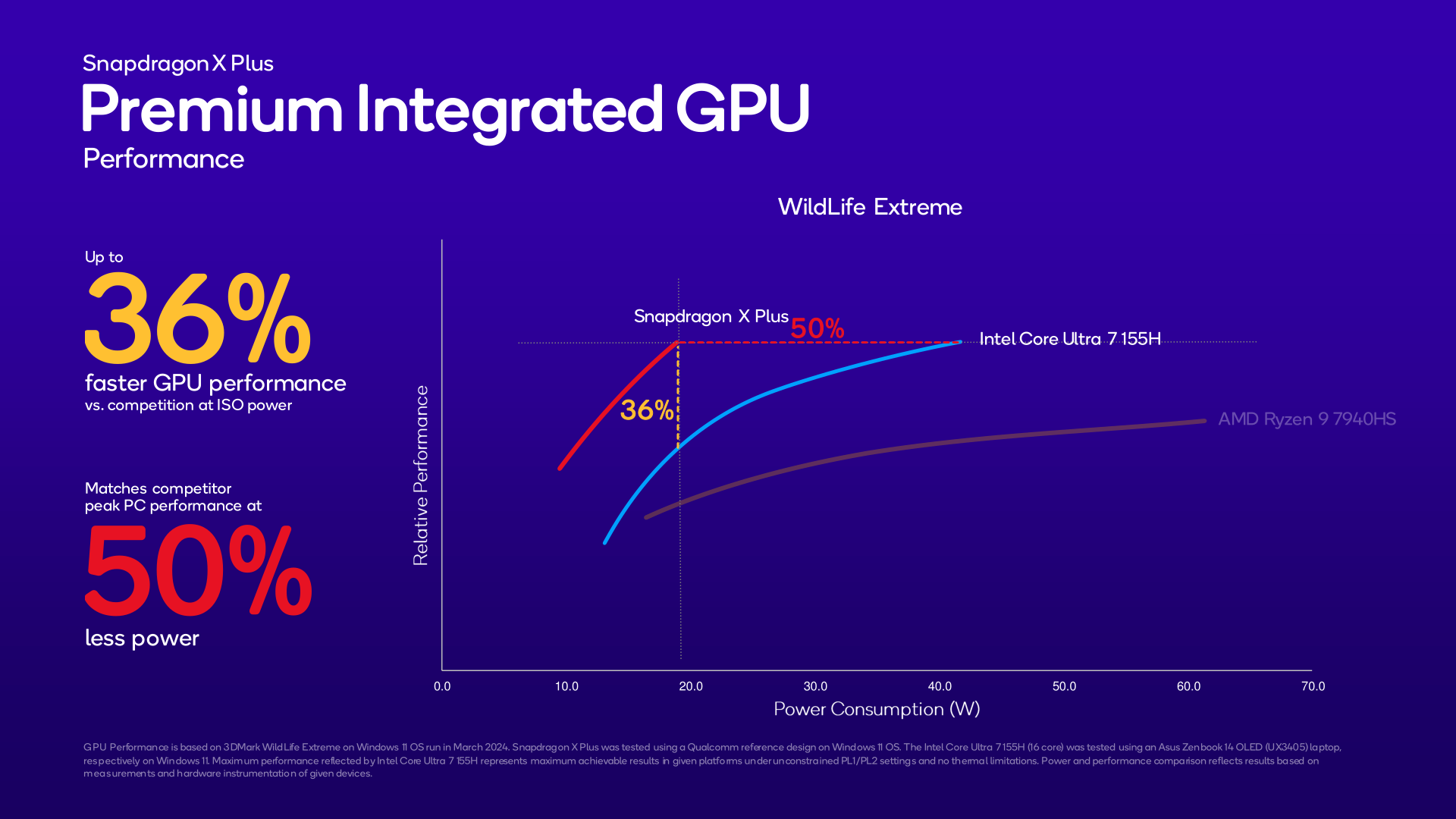







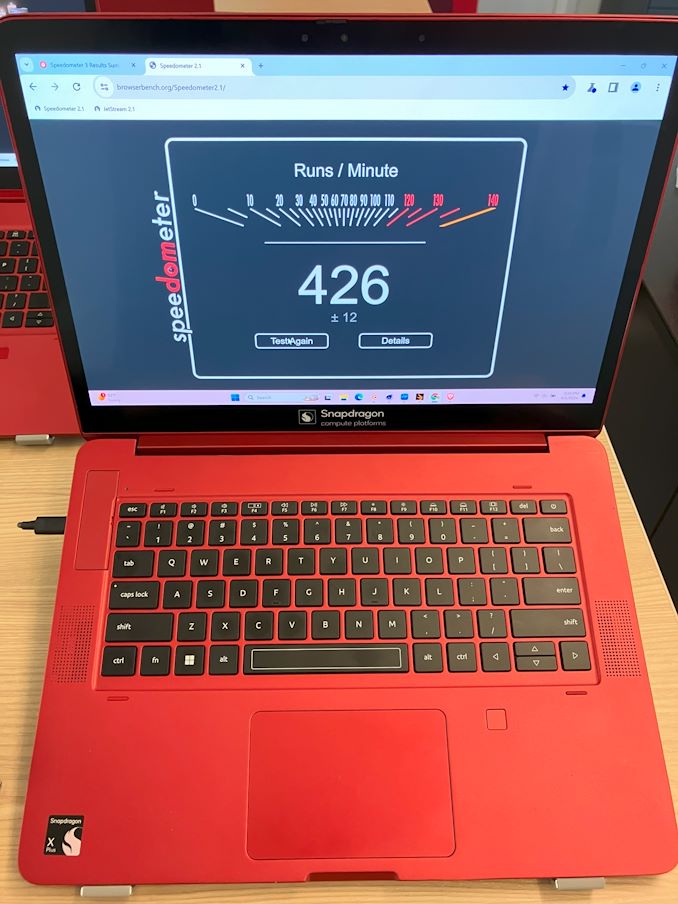

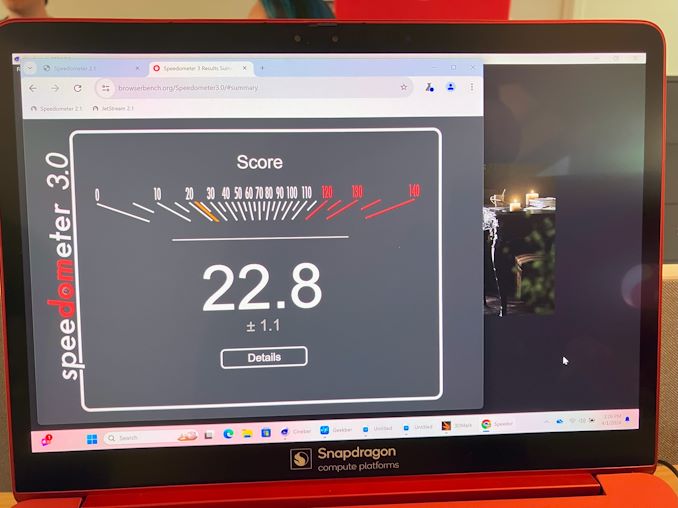









50 Comments
View All Comments
NextGen_Gamer - Thursday, April 25, 2024 - link
Thank you the reply Ryan! That is pretty crazy Qualcomm decided to go with a straight all big core setup, especially given their long history on the smartphone ARM side with big.LITTLE architectures. That does explain how X Elite and X Plus should easily outmatch Apple M3/Ryzen 8040/Core Ultra in multi-thread performance - no matter how you slice it, having 10 or 12 full perf cores is going to beat 4 or 6 or 8 of the competitor's ones. I did notice no single-thread benchmarks, so it will be interesting to see how each individual Oryon core compares to an M3 or Zen 4 or Redwood Cove. ReplyHifihedgehog - Thursday, April 25, 2024 - link
You are confusing Snapdragon X with Ryzen 9000 series Strix Point, AMD’s upcoming monolithic 12-core APU offering. The core configuration on Snapdragon X is purely homogeneous across all measures including feature set and so on. The only difference is binning which allows for higher two core boosting and a higher GPU clock for higher end SKUs. Replymeacupla - Wednesday, April 24, 2024 - link
I wonder if the X Plus an X Elite with 1 or 2 cores that didn't pass QC. ReplyRyan Smith - Wednesday, April 24, 2024 - link
That's more or less a given. Especially since the X1E-78-100 is the same specs with 12 CPU cores. Qualcomm would be shortchanging themselves by not having a salvage bin. Replymeacupla - Wednesday, April 24, 2024 - link
What I find particularly interesting is the NPU performance and cache size remain the same.It's a monolithic die, is it not?
I find it hard to believe the only defects that happen are in the CPU. Reply
Dolda2000 - Wednesday, April 24, 2024 - link
>I find it hard to believe the only defects that happen are in the CPU.More likely, the NPU and caches are built with internal redundancy where they have spare elements to compensate for defects. Reply
Ryan Smith - Wednesday, April 24, 2024 - link
We don't have a floor plan, but the NPU is thought to not be all that big. It's a dense array of systolic ALUs, but it shouldn't require much die space. So the odds of a defect hitting it, versus the much larger CPU clusters, is relatively low. Replymeacupla - Thursday, April 25, 2024 - link
Ah, I see. That is very interesting info, much appreciated. Replyhigh3r - Wednesday, April 24, 2024 - link
https://www.semiaccurate.com/2024/04/24/qualcomm-i... ReplyTerry_Craig - Wednesday, April 24, 2024 - link
It says that the real performance is up to 50% lower than the numbers presented by Qualcomm. In other words, the product hasn't even been launched yet and is already a total failure. Reply